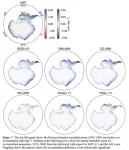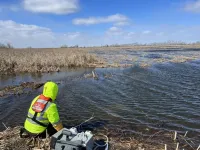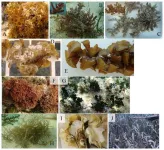(Press-News.org) Scattering sunlight-reflecting particles in the atmosphere could slow rapid melting in West Antarctica and reduce the risk of catastrophic sea-level rise, according to a study led by Indiana University researchers.
The study, one of the first to look at how climate engineering might impact Antarctica, comes as scientists sound the alarm over the increasing likelihood of accelerated ice loss in West Antarctica this century. The work appears in the Journal of Geophysical Research: Atmospheres.
“Even if the world meets the ambitious target of limiting global warming to 1.5 degrees Celsius above pre-industrial levels — which we are not on track to do — we are going to see significant sea-level rise,” said Paul Goddard, an assistant research scientist in the IU College of Arts and Sciences’ Department of Earth and Atmospheric Sciences and the lead author of the study. “Exploring ways to reflect sunlight into space before it is absorbed into Earth’s climate system could help buy us more time to address climate change and avoid or delay climate tipping points, such as collapse of the West Antarctic Ice Sheet.”
In addition to Goddard, co-authors on the paper include IU earth and atmospheric sciences assistant professor Ben Kravitz; Douglas MacMartin and Daniele Visioni of Cornell University; Ewa Bednarz with the National Oceanic and Atmospheric Administration; and Walker Lee of the National Center for Atmospheric Research.
The study explored a form of climate engineering called stratospheric aerosol injection, in which large amounts of tiny sulfur droplets are released into the stratosphere by a fleet of airplanes as a proposed method for keeping global temperatures in check.
The approach mimics what happens when a large volcano spews vast amounts of particles into the upper atmosphere and precipitates a cooling effect that can last months to years. It was recently discussed in a White House report outlining a potential research program on stratospheric aerosol injection and marine cloud brightening, another proposed strategy for cooling the planet.
Ten of the hottest years on record have occurred in the last 14 years. That’s including 2023, which is on track to supplant 2016 as the hottest year ever recorded. The spike in global temperatures has coincided with unprecedented heat waves, wildfires, flash flooding, and other climate-related impacts around the world.
In their study, IU researchers and collaborators used high-performance computers and global climate models to simulate different stratospheric aerosol injection scenarios, identifying the cooling strategy with the most potential to slow Antarctic ice loss. A portion of the data analysis conducted for the study took place on IU University Information Technology Services’ large-memory computer cluster, Carbonate.
“Where you release the aerosols matters a lot and can affect the climate differently,” Goddard said. “In this case, we found that releasing stratospheric aerosols at multiple latitudes within the tropics and sub-tropics, with a greater proportion in the Southern Hemisphere, is the best strategy for preserving land ice in Antarctica because it helps keep warm ocean waters away from the ice shelves.”
Researchers simulated 11 different stratospheric aerosol injection scenarios. Three cases spanned multiple latitudes — considered the most likely approach for how stratospheric aerosols injection might be implemented — with temperature targets of 1.5, 1 and 0.5 degrees Celsius above pre-industrial levels. The simulations, which started in 2035 and ran through 2070, included a moderate emissions scenario with no stratospheric aerosol injection that served as a key point of comparison.
Though simulated scenarios with stratospheric aerosol injection at multiple latitudes showed benefits in terms of Antarctic ice loss, further study is needed to quantify the change in melt rates, Goddard said.
Notably, several single-latitude injection scenarios actually accelerated Antarctic ice loss due to a southward shift of prevailing winds drawing warm ocean waters toward the ice shelves.
“If we’re ever going to engineer the climate, how we do it really matters,” Goddard said.
Some of the risks related to stratospheric aerosol injection, for example, include changes in regional precipitation patterns and the possibility of “termination shock,” a rapid rebound of global temperatures to pre-stratospheric aerosols injection levels should the decades-long treatment be interrupted.
The study adds to an expanding body of knowledge about the benefits and drawbacks of deliberately cooling the planet, a concept that is being discussed more widely as the effects of climate change become more prominent, Kravitz said.
“If society decides it wants to do geoengineering someday, we need to better understand what we know and what we don’t know,” he said. “We’re starting to fill some of these knowledge gaps on the risks and regional effects of managing solar radiation, but there’s a lot more research that needs to be done before anyone can say whether it’s a good idea to actually move forward with it. That’s true as much for Antarctica as it is for the rest of the planet.”
END
Climate engineering could slow Antarctic ice loss, study shows
2023-11-15
ELSE PRESS RELEASES FROM THIS DATE:
New report outlines microbial solutions to mediate methane emissions
2023-11-15
Washington, D.C.—The American Academy of Microbiology, the scientific think tank and honorific leadership group at the American Society for Microbiology (ASM), has released a new report, The Role of Microbes in Mediating Methane Emissions. The report highlights recommendations to further the scientific community’s understanding of microbial processes of methane production and consumption to mitigate methane emissions and address climate change.
Microbes can influence climate change through biogeochemical cycles that ...
NYU Tandon takes a quantum leap with new minor
2023-11-15
NYU Tandon School of Engineering is poised to become one of an extremely select group of American universities offering an undergraduate program in quantum technology, situating it at the forefront of a fast-growing field in which high employer demand significantly outpaces available talent.
Beginning in the spring 2024 semester, NYU Tandon students can start earning credits towards the new quantum tech minor, offered through the Department of Applied Physics.
In the past decade, quantum technology – the use of ...
Stand Up To Cancer announces three teams focused on gastroesophageal cancer
2023-11-15
LOS ANGELES – Nov. 15, 2023 – Stand Up To Cancer® (SU2C) today announced three Research Teams focused on bringing new therapies to clinical trials for the treatment of gastroesophageal cancer (GEC). The Research Teams, a part of a Dream Team Collective supported by the Torrey Coast Foundation, will unite top researchers from 11 institutions to address critical problems in GEC prevention, diagnosis and treatment. The Dream Team Collective aims to foster new and inclusive cancer research on the causes and treatments of GEC, mentor a new generation of scientists focused on GEC, bring ...
Should a hospital invest toward specializing in an area? Or diversify? The impact of a hospital’s portfolio strategy on patient demand
2023-11-15
Researchers from Indiana University and Texas Christian University published a new Journal of Marketing study that examines the impact of a hospital’s portfolio strategy on patient demand.
The study, forthcoming in the Journal of Marketing, is titled “Hospital Portfolio Strategy and Patient Choice” and is authored by Sarang Sunder and Sriram Thirumalai.
Structural changes in the healthcare industry (e.g., the institution of the Affordable ...
Surveilling wetlands for infectious bird flu — and finding it
2023-11-15
Recently, morning omelets and holiday dinners have gotten more expensive. One likely cause is bird flu, outbreaks of which led to the deaths of millions of chickens and turkeys from infection or culling in 2022, according to the U.S. Department of Agriculture, and which still demands rigorous monitoring of wild populations. Now, reporting in Environmental Science & Technology Letters, researchers have developed a method that detected infectious bird flu virus in wetlands frequented by waterfowl.
Wild birds represent a significant reservoir of avian influenza ...
Not so silver lining: Microplastics found in clouds could affect the weather
2023-11-15
From the depths of the seas to snow on mountains and even the air above cities, microplastics are turning up increasingly often. Now, in ACS’ Environmental Science & Technology Letters, researchers have analyzed microplastics in clouds above mountains. They suggest that these tiny particles could play a role in cloud formation and, in turn, affect weather.
Microplastics — plastic fragments smaller than five millimeters — originate from a myriad of items used daily, such as clothing, packaging and car tires. As research in the field evolves, scientists are not only detecting microplastics in the atmosphere but also investigating how they may play a role in cloud formation. ...
Association of molecular subtypes in bladder cancer with response to neoadjuvant chemotherapy, progression, and survival
2023-11-15
Considering the molecular subtype of muscle-invasive bladder cancer (MIBC) based on differences in tumor RNA expression can improve the ability of an existing tumor biomarker such as the COXEN score to predict which patients’ tumors are likely to respond to chemotherapy given before surgery. Individual molecular subtypes, however, were not associated with significant differences in patients’ overall survival (OS) or progression-free survival (PFS) times.
Those are the conclusions from a secondary analysis of data from the S1314 clinical trial, a large study in patients with MIBC that was conducted by the SWOG Cancer Research Network, a clinical trials group funded by ...
Colliding ribosomes activate RNA repair
2023-11-15
Aldehydes are toxic compounds that are produced in the body by metabolic processes, especially upon alcohol consumption. They are dangerous because they bind to cellular macromolecules such as DNA, RNA, and proteins, and crosslink them.
Crosslinking damage to DNA must be repaired by the cell to prevent premature aging and cancer. However, it was previously unknown whether and how cells sense and resolve crosslinking damage to single-stranded RNA. A team led by Professor Julian Stingele from ...
On two small islands in the Indian Ocean, an endangered palm with the world’s largest seed sows a lesson about landscape restoration
2023-11-15
Every tree species has its story. Unraveling all 73,000 of them is a significant undertaking for science, in no small part because a considerable proportion of tree biodiversity is tropical, rare, remote and subject to the ravages of deforestation. And an estimated 9,200 tree species have yet to be discovered.
Even trees well-known to science have mysteries. One is the Seychelles’ endangered coco de mer, or sea coconut palm tree, which is now relegated to parts of two small Indian Ocean islands and in decline. Only some 8,200 individuals remain.
What Lodoicea madivica lacks in range it makes ...
New scientific study reveals the crucial role of herbivorous fishes and sea urchins in restoring Caribbean coral reefs
2023-11-15
A new study by Dr. Lindsay Spiers (Florida Fish and Wildlife Conservation Commission) and Professor Thomas Frazer (College of Marine Science at the University of South Florida), published in PeerJ Life & Environment, presents crucial findings on the feeding preferences of herbivorous fishes and the sea urchin Diadema antillarum in Little Cayman. The study, titled "Comparison of feeding preferences of herbivorous fishes and the sea urchin Diadema antillarum in Little Cayman," sheds new light on the dynamics of these herbivores and their impact on the resilience of Caribbean coral reefs.
Caribbean coral reefs face significant challenges, ...







